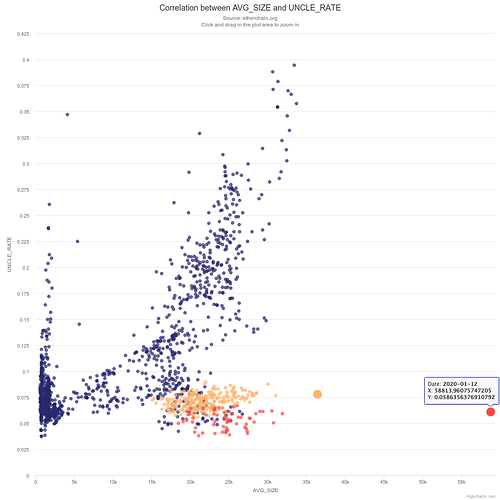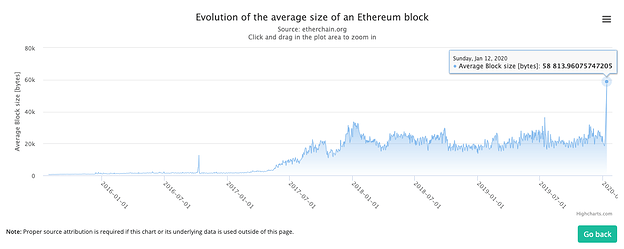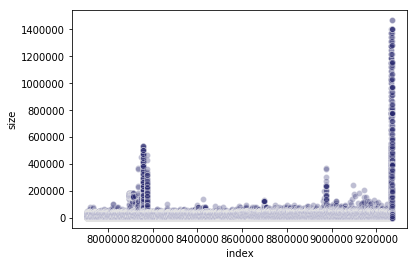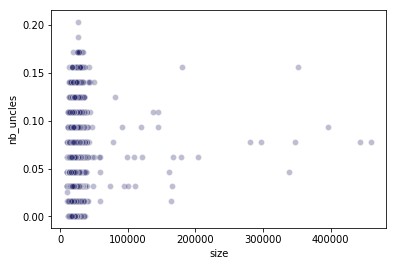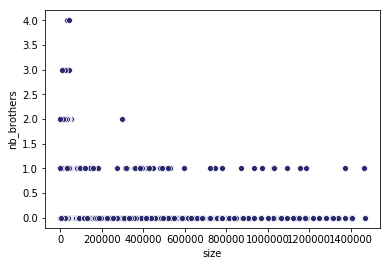EIP2028 - Post Istanbul/Muir Glacier Hardfork-- What Ethereum’s Mainnet Has to Say
TL/DR
Post Hardfork analysis of block size vs. uncle rate on Ethereum, including our high-load test conducted on Mainnet on Sunday January 20 2020, confirms our EIP-2028 Pre Hardfork analysis and suggests the network can even tolerate further reductions in transmission gas cost.
Introduction and the Hardforks timeline
On December 8th 2019 and January 2nd 2020, Ethereum upgraded respectively to Istanbul and Muir Glacier. EIP-2028 got included in Istanbul and Muir Glacier brought back the network to normal block time. On January 12th 2020, StarkWare proceeded with a post-upgrade analysis.
As argued in EIP 2028, reducing the gas cost of transmission would allow larger blocks and could affect network security, as measured by uncle rate. As previously, we use Etherchain as an independent source to analyse the correlation between average daily block size and uncle rate.
The plot below shows this correlation. The pre-March 2019 points are colored blue, the data between March 2019 and November 2019 is orange, and the latest data points are in red.
We will remind the readers that the drop in Uncle Rate compared to prior to March 2019 is mainly due to Parity propagation change as expressed previously. (Update: Vitalik’s link is broken and the bug was fixed in January 2019. Thanks to @evan_van_ness for the edit. Here is the link to the Parity github issue).
An additional observation can be made about the relative drop in November and December which is believed to be due to the Difficulty Bomb that was delayed with Muir Glacier.
This plot originated from https://etherchain.org/correlations.
The Big Dots
In our previous analysis, we created (and analyzed) what was then the day with the largest average blocksize in Ethereum’s history and observed the very limited impact of increased blocksize on Uncle Rate. On January 12 2020 (after Istanbul and Muir Glacier), we repeated the experiment. Thus, StarkWare is also responsible for the new Big Red Dot.
As seen above, the average blocksize on January 12th was roughly twice as large as the previous world record, which resulted from our previous experiment in July 2019. Here’s another view of this, from Etherchain.
In more detail, on Sunday January 12th 2020, we generated a large number of such transactions and submitted them to Ethereum’s mainnet, to measure the effect of larger blocks on uncle rate. These transactions were included within roughly 6,000 blocks, that varied in uncompressed size between 45KB-1.46MB. Here’s the first block in our experiment (114,513 Bytes uncompressed), here’s the last one (436,908 Bytes uncompressed) and this is the largest one (1,467,727 Bytes uncompressed). But, once again, despite an increased average size of roughly 2x, the big red dot in the plot above shows that this long period of large blocks had little noticeable effect on the daily uncle rate.
As a consequence, StarkWare believes that this analysis empirically proved the soundness of EIP-2028.
Big Red Dot in finer granularity
Here is a plot of the block size from the time of the previous experimentation (July 2019) to January 13th 2020. The two main peaks come from the blocks of our Pre and Post Istanbul experiments (the peak right before block 9000000 was an experiment we started and then terminated due to the acknowledgement of the Difficulty Bomb influence on the resulting numbers).
To parse this data at finer granularity, we took a small time window of 10,000 blocks and broke it into buckets of 50 blocks (roughly 11 minutes each). The next plot shows the uncle rate as a function of uncompressed block size. Bear in mind that the average uncompressed blocksize is 23KB, compressed to an average of 15KB. We maintained a similar compression ratio (of roughly 2x) for the blocks in our test, even though we managed to generate blocks that are 65x larger than the average (max-ing at 1.46MB uncompressed). The buckets of 50 consecutive blocks during our experiment were up to 21x larger than average, improving on our previous largest bucket (from our pre-Istanbul experiment) by almost 3x. As can be seen, there is little to no effect on uncle rate per bucket.
A block brother is a block that is not part of the main chain, but sits at the same height as another block (i.e., brothers are uncles, but attributed to individual mainnet blocks). The next plot shows brother count as a function of individual block size. Inspecting this plot, we still see no adverse effect of increased block size, confirming the same prediction from our previous analysis.
Summary
To conclude, increasing the average block size by a factor of 20x shows no adverse effect on the security of Ethereum’s Mainnet (Post-Istanbul§ and Post-Muir-Glacier), nor do we see any deleterious effects from increasing individual blocksize by a factor of 65x. Based on this, we believe that the new gas cost of data transmission adopted with EIP-2028 was well-founded, and even further gas reductions seem warranted (to be discussed by the community later).
